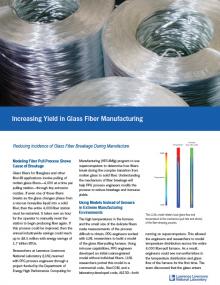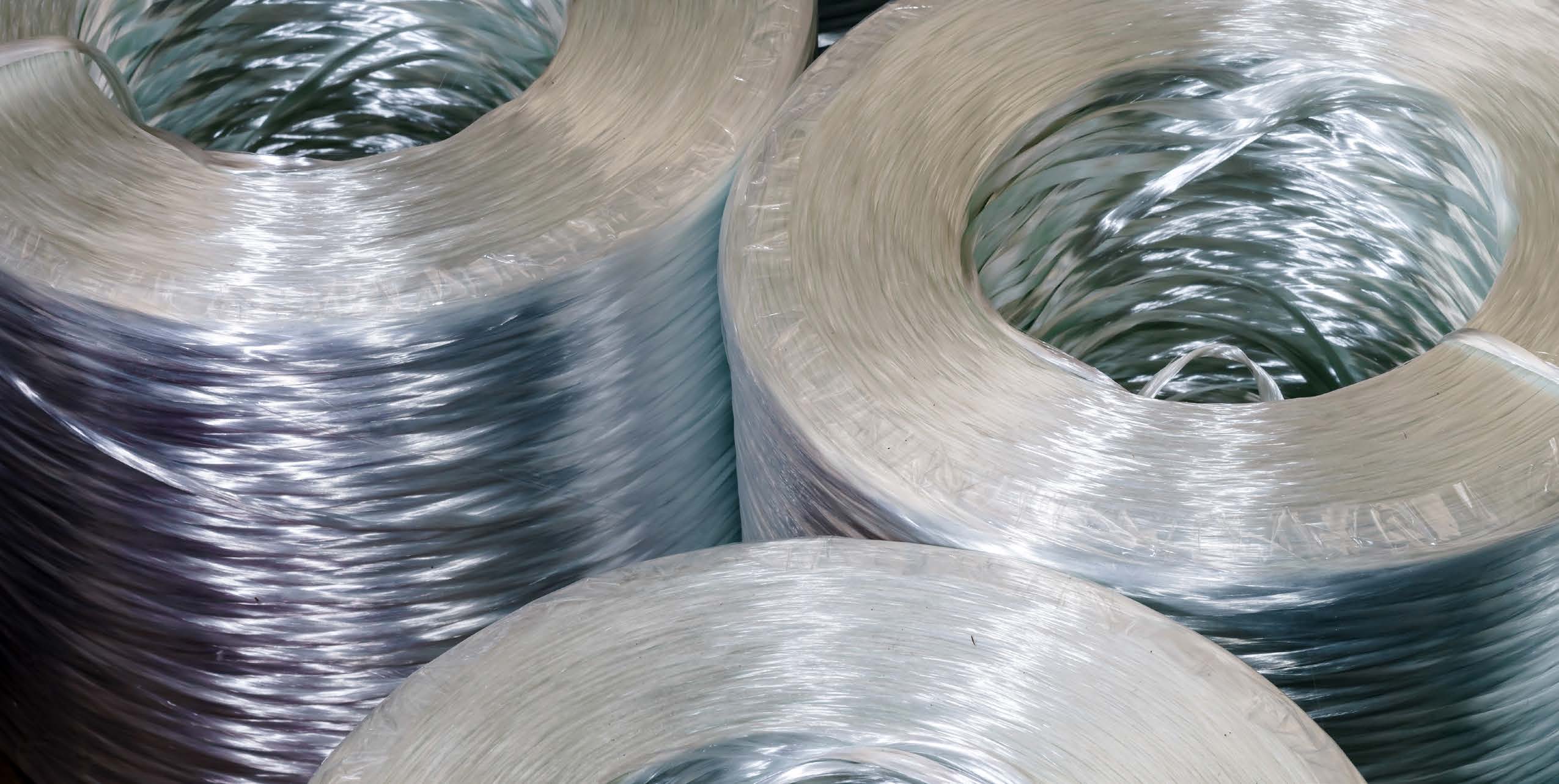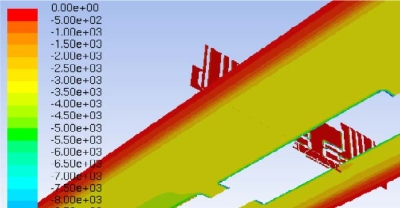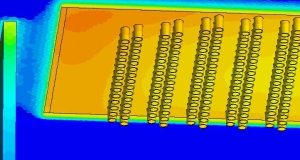Success Stories
Reducing Glass Fiber Breakage

PPG Industries | Lawerence Livermore National Laboratory

PPG Industries is working with Livermore Lab to use supercomputers to modify the process of converting molten glass to solid fiber to reduce breakage and increase yields.
Impact

Increasing Yield in Glass Fiber Manufacturing
Reducing Incidence of Glass Fiber Breakage During Manufacture
Modeling Fiber Pull Process Shows Cause of Breakage
Glass fibers for fiberglass and other fiber-fill applications involve pulling of molten glass fibers—4,000 at a time per pulling station—through tiny extrusion nozzles. If even one of these fibers break as the glass changes phase from a viscous honey-like liquid into a solid fiber, then the entire 4,000-fiber station must be restarted. It takes over an hour for the operator to manually reset the station to begin producing fiber again. If this process could be improved, then the annual industrywide savings could reach up to $8.5 million with energy savings of 1.7 trillion BTUs.
Researchers at Lawrence Livermore National Laboratory (LLNL) teamed with PPG process engineers through a project funded by the Department of Energy High Performance Computing for Manufacturing (HPC4Mfg) program to use supercomputers to determine how fibers break during the complex transition from molten glass to solid fiber. Understanding the mechanism of fiber breakage will help PPG process engineers modify the process to reduce breakage and increase yields.
Using Models Instead of Sensors in Extreme Manufacturing Environments

The high temperatures in the furnace and the small size of the delicate fibers make measurements of the process difficult to obtain. PPG engineers worked with LLNL researchers to build a model of the glass fiber-pulling furnace. Using in-house capabilities, PPG engineers developed an initial coarse-grained model without individual fibers. LLNL researchers ported this model to a commercial code, Star-CCM, and a laboratory-developed code, ALE3D—both running on supercomputers. This allowed the engineers and researchers to model temperature distribution across the entire 4,000 fiber-pull furnace. As a result, engineers could see non-uniformities in the temperature distribution and glass flow of the furnace for the first time. The team discovered that the glass enters at a single temperature but loses more heat than expected through the flow channel and the bushings as it traverses the furnace.
LLNL researchers also used advanced simulation codes to model the actual drawing of the glass fibers. This process is very complex with many factors such as air currents, radiant heat transfer though transparent media, and glass phase transforma- tions—all of which affect the geometry and stresses in the glass. While the modeling predicted the reduction of fiber diameter throughout the process, achieving accurate diameters that matched operational sizes would be the subject of future effort. In addition, with continuing work to add advanced adaptive meshing, the fiber model could provide the local stress in a fiber during perturbations—such as sudden temperature or air flow variations. This was not possible with the analytical models previously used to study fiber behavior.
Process Improvements Through Combined Computational and Experimental Efforts

Future experimental efforts coupled with computational efforts will investigate a range of likely sources of fiber breakage in the glass flow due to airflow instabilities or particulates in the glass melt, and could resolve the question of the source of fiber breakage. The range of possibilities could be narrowed by careful experiments such as high-speed photography, then followed by a well-focused modeling effort to better understand the problem.
This work has the potential to allow large savings in energy and reduce wasted materials. PPG has estimated that improving the fiber yield by a single percentage point would give an additional $1 million in salable product per year.
How to Work with Us
For more information, visit hpc4mfg.org or contact us at hpc4mfg [at] llnl.gov (hpc4mfg[at]llnl[dot]gov).

Your Success Story Awaits
HPC4EI brings together the diverse set of computational skills and supercomputing capabilities of DOE National Laboratories to increase US industry’s energy efficiency and advance competitiveness. Learn about the next opportunity to partner with the superb talent and high performance computing platforms at DOE National Laboratories.
Have questions?
Please email hpc4ei [at] llnl.gov (subject: HPC4EI%20Assistance%20%28Success%20Story%29) (hpc4ei[at]llnl[dot]gov) for further assistance.
Other Success Stories
| Title | Company | Laboratory |
|---|---|---|
| Microwave-assisted Ceramic Processing | Raytheon | Oak Ridge National Laboratory |
| Chemical Vapor Infiltration | General Electric | Oak Ridge National Laboratory |
| Microscopic Concentration Gradients | Flash Steelworks, Inc. | Oak Ridge National Laboratory |
| Molten-Sulfur Storage | Element 16 Technologies, Inc. | National Renewable Energy Laboratory |
| Heat Exchangers | Materials Sciences, LLC | Lawrence Livermore National Laboratory |
| Gas Turbines and HPC | Raytheon Technologies Research Center | Argonne National Laboratory |
| Next Generation Additive Manufacturing | Seurat Technologies | Lawrence Livermore National Laboratory |
| Improved Aluminum Ingot Casting | Arconic | Lawrence Livermore National Laboratory & Oak Ridge National Laboratory |
| Next-Generation LEDs | SORAA | Lawrence Livermore National Laboratory |
| Energy Efficiency in Paper Processing | Agenda 2020 Technology Alliance | Lawrence Livermore National Laboratory & Berkeley National Laboratory |
| Reducing Glass Fiber Breakage | PPG Industries | Lawrence Livermore National Laboratory |
| Optimizing Lightweight Materials | Lightweight Innovation for Tomorrow (LIFT) | Lawrence Livermore National Laboratory |
| Glass Furnace Model Enhancement | Vitro Glass Company |
Lawrence Livermore National Laboratory |
| Improve Water Evaporation Processes | Zoom Essence |
Lawrence Livermore National Laboratory |
About HPC4EI
High Performance Computing for Energy Innovation (HPC4EI) is funded by the Department of Energy’s Energy Efficiency and
Renewable Energy’s (EERE) Advanced Materials and Manufacturing Technologies Office (AMMTO), Industrial Efficiency and Decarbonization Office (IEDO) and Office of Fossil Energy and Carbon Management (FECM). The HPC4EI program pairs industry engineers and scientists with national laboratory computational experts to solve difficult production and design problems aiming to reduce national energy consumption. Since its inception 2015, the HPC4EI program has funded over 182 projects with participation by 11 different national laboratories. The world-class computational capabilities at the national laboratories are used to address problems in steel and aluminum manufacture, jet turbine design and manufacture, advanced materials for light weighting and high temperature, high corrosion applications, chemical processing and many more topic areas.




